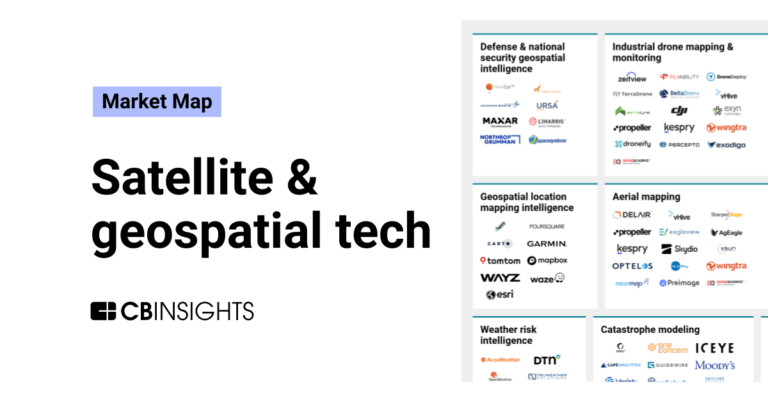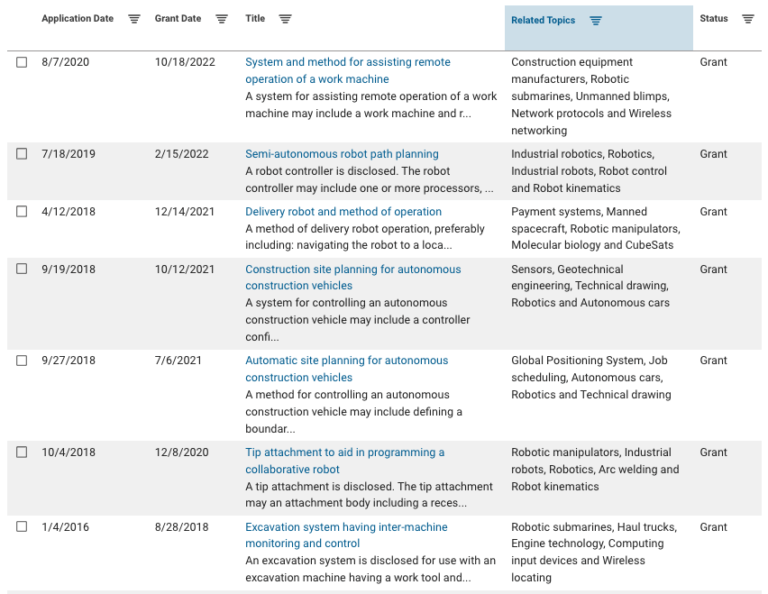
DroneDeploy
Founded Year
2013Stage
Series E | AliveTotal Raised
$141.02MLast Raised
$50M | 4 yrs agoMosaic Score The Mosaic Score is an algorithm that measures the overall financial health and market potential of private companies.
-59 points in the past 30 days
About DroneDeploy
DroneDeploy specializes in reality capture software, focusing on drone mapping and photo documentation across various industries. The company provides a platform that enables commercial drones and ground robots to capture and organize photos, generate maps, and produce inspection reports, all integrated with AI for data analysis. DroneDeploy serves sectors such as construction, agriculture, and energy, offering solutions tailored to automate inspections and improve operational efficiency. DroneDeploy was formerly known as Infatics. It was founded in 2013 and is based in San Francisco, California.
Loading...
DroneDeploy's Product Videos


ESPs containing DroneDeploy
The ESP matrix leverages data and analyst insight to identify and rank leading companies in a given technology landscape.
The reality capture market involves using technology such as drones and cameras to capture physical environments and assets, and transform them into digital twins or reality models. This includes technologies such as 3D scanning, photogrammetry, LiDAR, and laser scanning. These digital representations provide valuable insights for industries such as construction, energy, and agriculture, helping t…
DroneDeploy named as Outperformer among 14 other companies, including Autodesk, Hexagon, and Trimble.
DroneDeploy's Products & Differentiators
Site Reality Solution
Create digital twins of physical structures, assets, and environments via drones, ground robots, or cameras. How it works: Capture - Mobile-based and scalable for all users, the DroneDeploy Walkthrough & Flight Apps automatically collect, organize, and send visual data for processing. Analyze - DroneDeploy’s online workspace allows teams to add, organize, and tour walkthrough paths, aerial maps, 3D models in one place. Quickly assess progress, issues, and opportunities by viewing site reality compared against past maps or design plans. Share - Stakeholders can access data virtually to inspect, generate issues, and share results with embedded public share links.
Loading...
Research containing DroneDeploy
Get data-driven expert analysis from the CB Insights Intelligence Unit.
CB Insights Intelligence Analysts have mentioned DroneDeploy in 3 CB Insights research briefs, most recently on Mar 1, 2024.

Mar 1, 2024
The satellite & geospatial tech market map
Dec 18, 2023
The P&C claims tech stack market mapExpert Collections containing DroneDeploy
Expert Collections are analyst-curated lists that highlight the companies you need to know in the most important technology spaces.
DroneDeploy is included in 7 Expert Collections, including Construction Tech.
Construction Tech
1,404 items
Companies in the construction tech space, including additive manufacturing, construction management software, reality capture, autonomous heavy equipment, prefabricated buildings, and more
Robotics
2,006 items
This collection includes startups developing autonomous ground robots, unmanned aerial vehicles, robotic arms, and underwater drones, among other robotic systems. This collection also includes companies developing operating systems and vision modules for robots.
Advanced Manufacturing
3,619 items
Companies in the advanced manufacturing tech space, including companies focusing on technologies across R&D, mass production, or sustainability
Job Site Tech
864 items
Companies in the job site tech space, including technologies to improve industries such as construction, mining, process engineering, forestry, and fieldwork
Aerospace & Space Tech
4,069 items
These companies provide a variety of solutions, ranging from industrial drones to electrical vertical takeoff vehicles, space launch systems to satellites, and everything in between
Renewable Energy
4,805 items
DroneDeploy Patents
DroneDeploy has filed 11 patents.
The 3 most popular patent topics include:
- operating amusement attractions
- unmanned aerial vehicle manufacturers
- 3d imaging

Application Date | Grant Date | Title | Related Topics | Status |
|---|---|---|---|---|
7/20/2022 | 7/9/2024 | Investment, Private equity, Infrared imaging, Disability sport classifications, Financial markets | Grant |
Application Date | 7/20/2022 |
|---|---|
Grant Date | 7/9/2024 |
Title | |
Related Topics | Investment, Private equity, Infrared imaging, Disability sport classifications, Financial markets |
Status | Grant |
Latest DroneDeploy News
Oct 31, 2024
Climate solutions—powered by digital infrastructure—are unlikely to go anywhere quickly. by: Since the announcement of the IRA two years ago, the U.S. has experienced the biggest clean energy investment boom in its history. Approximately $78 billion has been invested by the government across the U.S. economy through the IRA, focusing on clean energy manufacturing, decarbonizing technologies, and clean vehicle infrastructure. This has created huge tailwinds across the climate ecosystem, driving down production costs, scaling domestic technology manufacturing, and stimulating First of a Kind (FOAK) technologies. The crux of the IRA is its function of shifting the economic dynamics of clean energy from a punitive (“stick”) approach to a more incentivized (“carrot”) model, providing significant tax rebates and investment incentives that enable climate technology’s ability to compete with GHG-heavy industries. This shift has spurred other global powers like the EU and Canada to implement similar strategies, aiming to enhance clean domestic manufacturing and stimulate their own climate economies. And there have been massive impacts: since the launch of the IRA, domestic solar panel production capacity has increased by nearly four times , and batteries are quickly following suit. Solar is already the cheapest form of power generation in some parts of the U.S., and the IEA anticipates that solar + storage facilities will soon be cheaper than gas-fired power. This growth is also driving a new chapter in clean energy labor. In 2023 alone, over 42,000 jobs were created within the manufacturing sector for clean energy and electric vehicles. As we face the upcoming U.S. election, some stakeholders in the private capital community have questioned if a change in administration would significantly impede the climate sector’s momentum by rolling back these tailwinds. Many funds are building dry powder and executing a “wait-and-see”strategy before the next phases, and founders are tightening up their margins as follow-on rounds are difficult to come by. But climate policy—and climate momentum—is likely to be much stickier than these sentiments imply. 1. The IRA is a windfall, not the backbone of the energy transition. Where the IRA has funneled $78 billion in public dollars into the climate sector, private investment has followed at an even higher magnitude, bringing total investment to $493 billion— a 71% increase compared to the two years prior. Clean technology now accounts for 4.5% of total private investment in the U.S., up from 2.5% pre-IRA. We’ve also seen an increase in foreign direct investment , indicating that American innovation is garnering global interest in U.S. tech and opening new opportunities to win emerging markets. 2. Investing in climate solutions means investing in infrastructure. Both political parties have spoken to the essential need for a modernized grid. Between data centers driving up energy demand for the first time in over 10 years , interconnection issues bottlenecking energy projects, and extreme weather adding more stress to the grid every year, grid modernization is a top priority for the basic functionality of our economy. These investments directly correlate to the integration of clean technology; batteries, renewable generation, and distribution optimization, including VPPs and DERs, are all essential pieces to the U.S. energy transmission problem, and we expect to continue to see investments in these technologies regardless of administration. 3. The energy transition rests on manufacturing—and manufacturing is happening across the country. IRA funds have funneled across the U.S. regardless of local climate agendas, with states leading in total clean energy investment as a percentage of their GDP including Nevada, Wyoming, Arizona, Tennessee, and Montana. This influx of capital has led lawmakers across the aisle to advocate for a “scalpel” approach to the IRA rather than a “sledgehammer,” reflecting hesitancy to roll back support for active projects for fear of undermining private investments or stopping development. Notably, a proportion of dollars have flowed directly to disadvantaged and under-resourced areas through programs like the Greenhouse Gas Reduction Fund (GGRF), tackling unemployment and improving quality of life across the South and Southwest. 4. If cuts happen to the IRA, it’s likely these cuts will hit consumer-side benefits, not development incentives. The areas receiving the most partisan criticism—such as tax credits for purchasing EVs, improving home energy efficiency, or installing heat pumps—may be on the chopping block should there be a significant policy shift in 2025. While the loss of these credits may alter consumer behavior, utility-scale renewable developers are unlikely to change course. As unit economics improve with scale, a competitive market will continue to foster innovation in energy generation, distribution, and storage, meeting growing energy demand with clean generation. Though election uncertainty has already created some fluctuations across the industry, these have been technology-specific, not rejections of the broader climate investment. What does this mean for climate software? Public and private investment in climate technology has been enabled by digital tools streamlining the flow and use of these funds. These software solutions have been pivotal for developers large and small to access new funds, deploy them efficiently, and monitor them correctly to meet climate goals. By enhancing everything from fund allocation to on-the-ground project management, software solutions have helped to maximize and reinforce the benefits of the IRA, even in a shifting political landscape. The importance of software has gained increasing attention from investors, as software now captures about a third of climate tech VC investment, marking a 17% compound annual growth rate (CAGR)1. Examples of these software solutions lie at each stage of project development and operations. Banyan Infrastructure 's platform specifically accelerates project finance workstreams by simplifying loan management, compliance tracking, and reporting requirements for renewable infrastructure funds and green banks or community lenders managing public capital, like the GGRF. These tools help institutions save significant time and labor brought on by reporting requirements—the EPA estimated overhead costs of $1M to $15M for annual reporting—while monitoring program health and improving project results. Additionally, improvements in photogrammetry and AI have found applications through platforms like DroneDeploy , which generates reports visually showing project progress and analyzing percent completion, boosting renewable project build efficiency by up to 70%. DroneDeploy’s software also enhances the productivity of solar operations by performing automated inspections using thermal drones to detect heat anomalies. These automated inspections can reduce costs by up to 40%, increase solar panel uptime, and help renewable generation investments go further. Coordinating these operational and technological elements, platforms like Sitetracker provide oversight across the entire asset lifecycle and centralize the management of planning, building, and maintaining these assets. The platform enables real-time oversight of project timelines, costs, and resources, while automating workflows and improving transparency. This “single source of truth” helps projects stay on track, optimizes preventative maintenance, and protects long-term returns on IRA investments. Software solutions like these not only enable the climate sector but broaden the benefits of climate innovations. Breakthroughs in the climate field have had ripple effects across the ecosystem, with learnings from the renewables market transferring toward data center efficiency, construction workforce management, weather forecasting, and utilities operations and maintenance. Emerging fields, including AI optimization and digital twin technology, will all prove to be essential across manufacturing, especially as the U.S. pursues grid reformation. In other words, investment in climate software has proven to be an investment in the U.S. economy writ large, and we believe this trend will sustain. Looking Forward Despite political uncertainty, the climate technology sector continues to show promise and potential. Valuations have hit healthy levels, businesses are running efficiently, technology is scaling, and U.S. innovation is reaching new milestones every day. Investors, founders, and communities will continue to see and feel the value of climate investment. The underlying drivers of climate technology—from solar power to battery chemistry—remain independent of political shifts, and the market will continue to respond. 1) Energize Capital Analysis, Pitchbook
DroneDeploy Frequently Asked Questions (FAQ)
When was DroneDeploy founded?
DroneDeploy was founded in 2013.
Where is DroneDeploy's headquarters?
DroneDeploy's headquarters is located at 548 Market St. #34583, San Francisco.
What is DroneDeploy's latest funding round?
DroneDeploy's latest funding round is Series E.
How much did DroneDeploy raise?
DroneDeploy raised a total of $141.02M.
Who are the investors of DroneDeploy?
Investors of DroneDeploy include AngelPad, Uncork Capital, Emergence Capital, Scale Venture Partners, AirTree Ventures and 11 more.
Who are DroneDeploy's competitors?
Competitors of DroneDeploy include Exyn Technologies, Aethero, Drone Ag, Percepto, Proofminder and 7 more.
What products does DroneDeploy offer?
DroneDeploy's products include Site Reality Solution and 2 more.
Who are DroneDeploy's customers?
Customers of DroneDeploy include Sunrun and Corteva.
Loading...
Compare DroneDeploy to Competitors

Exyn Technologies is a company focused on the development of autonomous aerial robot systems. The company's main offerings include aerial robot software enabling it to operate in GPS-denied environments and perform safe, and 3D mapping in high-risk areas. It serves the mining, government, and construction sectors. It was founded in 2014 and is based in Philadelphia, Pennsylvania.

DJI specializes in innovative drone and camera technology for both commercial and recreational use within the aerospace and photography sectors. The company offers a range of products including consumer drones, professional cinematography tools, and handheld camera stabilizers designed to capture smooth photo and video content. DJI also provides enterprise solutions with aerial platforms, payloads, and analytic tools for industries such as agriculture, construction, and public safety. DJI was formerly known as Dajiang Innovation Technology. It was founded in 2006 and is based in Shenzhen, Guangdong.

Propeller is a company specializing in providing drone technology and data solutions for the construction, mining, and waste management sectors. Their main offerings include a cloud-based platform for mapping, measuring, and managing worksites with survey-grade accuracy, as well as tools for earthwork tracking, volume calculations, and subcontractor management. It was founded in 2014 and is based in Surry Hills, New South Wales.

Kespry is a company focused on providing drone-based aerial intelligence for various industries. Their main offerings include an analytics platform that allows enterprises to inspect, measure, analyze, and report visual data for better decision-making. Kespry's solutions cater to sectors such as mining and aggregates, construction, pulp and paper, and process industries. It was founded in 2013 and is based in San Antonio, Texas.

Skycatch is a company specializing in drone automation and data analysis within various industrial sectors. Their main offerings include a platform for drone-based data collection and analytics, as well as tools for project management, fleet compliance, and centralized data handling. They provide solutions that cater to the needs of construction, mining, and energy companies. It was founded in 2013 and is based in San Francisco, California.

Skydio specializes in aerial robotics and autonomous drones within the technology sector. The company offers drones that autonomously capture and process data using artificial intelligence (AI) and computer vision, designed for a variety of applications including inspections, public safety, and defense. Skydio's products are utilized across sectors such as public safety, defense, energy, utilities, and other industries requiring advanced aerial data capture and analysis. It was founded in 2014 and is based in San Mateo, California.
Loading...
